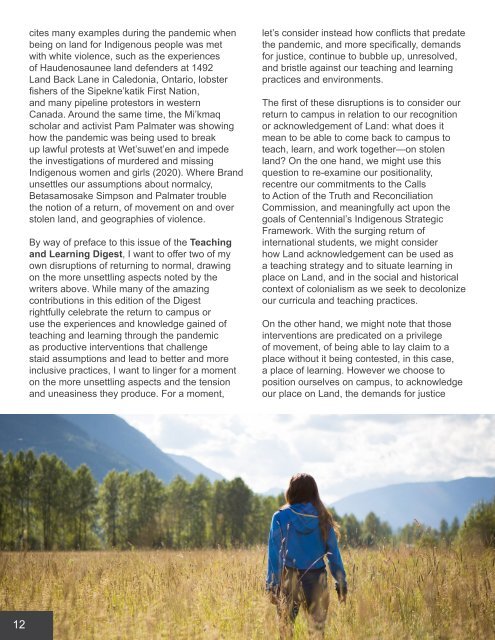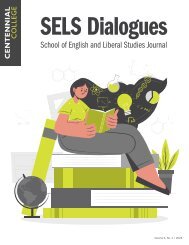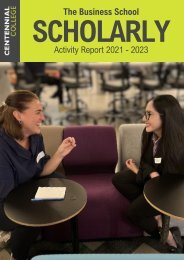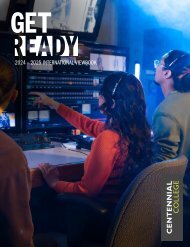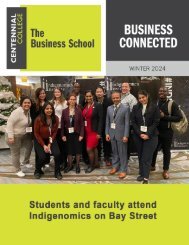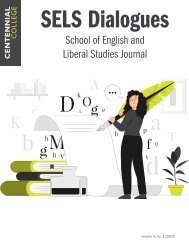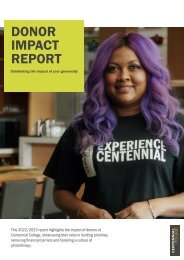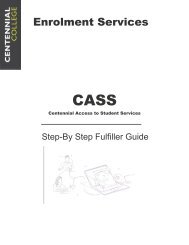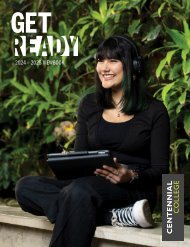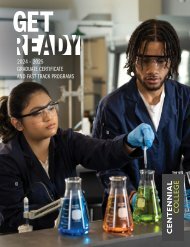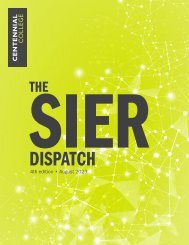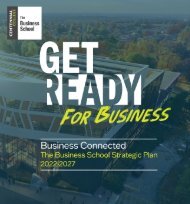The Teaching and Learning Innovation Digest - May 2023
Welcome to a truly special edition of the Teaching and Learning Innovation Digest! Our seventh annual academic publication has assumed an incredibly meaningful shape and form for a number of reasons. Not only did we receive an enthusiastic response with over 30 submissions via our institutional broadcast, but we also have consciously and intentionally embraced the principles of Universal Design for Learning by attempting to represent and celebrate the varied forms of expressions therein. From reflective essays, poetry, visual and performing arts, podcasts, video conversations to scholarly work, academic and applied research, news and updates, and interviews, this is truly a power-packed publication!
Welcome to a truly special edition of the Teaching and Learning Innovation Digest! Our seventh annual academic publication has assumed an incredibly meaningful shape and form for a number of reasons. Not only did we receive an enthusiastic response with over 30 submissions via our institutional broadcast, but we also have consciously and intentionally embraced the principles of Universal Design for Learning by attempting to represent and celebrate the varied forms of expressions therein. From reflective essays, poetry, visual and performing arts, podcasts, video conversations to scholarly work, academic and applied research, news and updates, and interviews, this is truly a power-packed publication!
You also want an ePaper? Increase the reach of your titles
YUMPU automatically turns print PDFs into web optimized ePapers that Google loves.
cites many examples during the p<strong>and</strong>emic when<br />
being on l<strong>and</strong> for Indigenous people was met<br />
with white violence, such as the experiences<br />
of Haudenosaunee l<strong>and</strong> defenders at 1492<br />
L<strong>and</strong> Back Lane in Caledonia, Ontario, lobster<br />
fishers of the Sipekne’katik First Nation,<br />
<strong>and</strong> many pipeline protestors in western<br />
Canada. Around the same time, the Mi’kmaq<br />
scholar <strong>and</strong> activist Pam Palmater was showing<br />
how the p<strong>and</strong>emic was being used to break<br />
up lawful protests at Wet’suwet’en <strong>and</strong> impede<br />
the investigations of murdered <strong>and</strong> missing<br />
Indigenous women <strong>and</strong> girls (2020). Where Br<strong>and</strong><br />
unsettles our assumptions about normalcy,<br />
Betasamosake Simpson <strong>and</strong> Palmater trouble<br />
the notion of a return, of movement on <strong>and</strong> over<br />
stolen l<strong>and</strong>, <strong>and</strong> geographies of violence.<br />
By way of preface to this issue of the <strong>Teaching</strong><br />
<strong>and</strong> <strong>Learning</strong> <strong>Digest</strong>, I want to offer two of my<br />
own disruptions of returning to normal, drawing<br />
on the more unsettling aspects noted by the<br />
writers above. While many of the amazing<br />
contributions in this edition of the <strong>Digest</strong><br />
rightfully celebrate the return to campus or<br />
use the experiences <strong>and</strong> knowledge gained of<br />
teaching <strong>and</strong> learning through the p<strong>and</strong>emic<br />
as productive interventions that challenge<br />
staid assumptions <strong>and</strong> lead to better <strong>and</strong> more<br />
inclusive practices, I want to linger for a moment<br />
on the more unsettling aspects <strong>and</strong> the tension<br />
<strong>and</strong> uneasiness they produce. For a moment,<br />
let’s consider instead how conflicts that predate<br />
the p<strong>and</strong>emic, <strong>and</strong> more specifically, dem<strong>and</strong>s<br />
for justice, continue to bubble up, unresolved,<br />
<strong>and</strong> bristle against our teaching <strong>and</strong> learning<br />
practices <strong>and</strong> environments.<br />
<strong>The</strong> first of these disruptions is to consider our<br />
return to campus in relation to our recognition<br />
or acknowledgement of L<strong>and</strong>: what does it<br />
mean to be able to come back to campus to<br />
teach, learn, <strong>and</strong> work together—on stolen<br />
l<strong>and</strong>? On the one h<strong>and</strong>, we might use this<br />
question to re-examine our positionality,<br />
recentre our commitments to the Calls<br />
to Action of the Truth <strong>and</strong> Reconciliation<br />
Commission, <strong>and</strong> meaningfully act upon the<br />
goals of Centennial’s Indigenous Strategic<br />
Framework. With the surging return of<br />
international students, we might consider<br />
how L<strong>and</strong> acknowledgement can be used as<br />
a teaching strategy <strong>and</strong> to situate learning in<br />
place on L<strong>and</strong>, <strong>and</strong> in the social <strong>and</strong> historical<br />
context of colonialism as we seek to decolonize<br />
our curricula <strong>and</strong> teaching practices.<br />
On the other h<strong>and</strong>, we might note that those<br />
interventions are predicated on a privilege<br />
of movement, of being able to lay claim to a<br />
place without it being contested, in this case,<br />
a place of learning. However we choose to<br />
position ourselves on campus, to acknowledge<br />
our place on L<strong>and</strong>, the dem<strong>and</strong>s for justice<br />
in relation to Indigenous l<strong>and</strong> rights <strong>and</strong><br />
sovereignty remain unresolved. I suspect<br />
many of us feel that uneasiness in reading<br />
the L<strong>and</strong> acknowledgement, even a sense of<br />
something approaching hypocrisy, when setting<br />
it alongside the colonial legacy of l<strong>and</strong> theft,<br />
the ongoing protests for L<strong>and</strong> Back, very real<br />
restrictions on the movement of Indigenous<br />
peoples, <strong>and</strong> the geographies of violence that<br />
surround us. Do we feel that same uneasiness<br />
when making a claim to the importance of<br />
being <strong>and</strong> learning on campus, of having that<br />
campus experience? It’s in this context that<br />
we should ask: what assumptions are we<br />
making about our own privilege of movement<br />
<strong>and</strong> sense of claim to place <strong>and</strong> that of our<br />
colleagues <strong>and</strong> students? How can we take<br />
that sense of urgency that some of us might<br />
have felt about getting back to in-person<br />
learning <strong>and</strong> apply it to the incompleteness<br />
of our work in realizing the goals of the<br />
Indigenous Strategic Framework?<br />
<strong>The</strong> idea of examining <strong>and</strong> interrogating the<br />
privileges we assume in returning to campus<br />
also opens up the possibility of a further<br />
disruption of normalcy, a disruption that helps<br />
to further uncover the systemic ableism of our<br />
teaching <strong>and</strong> learning environments. When the<br />
p<strong>and</strong>emic first happened <strong>and</strong> courses shifted<br />
to remote delivery, many disabled student<br />
groups noted that the interventions that were<br />
being made—increased flexibility, recording<br />
of lectures, providing course materials in the<br />
<strong>Learning</strong> Management System—had been the<br />
key dem<strong>and</strong>s of campus disability advocates<br />
for many years. <strong>The</strong> p<strong>and</strong>emic was a crisis of<br />
access to education on a large scale, <strong>and</strong> the<br />
irony was often noted that a shift in the culture<br />
of access was possible, that interventions<br />
could be put into practice effectively overnight,<br />
but only when they served the needs of the<br />
majority learner.<br />
At the same time, disabled students also noted<br />
how the shift to remote learning amplified<br />
barriers to access related to technology <strong>and</strong><br />
online learning (Loeppky, 2022). Even more so,<br />
because academic accommodations tend to be<br />
focused on the needs of disabled students in<br />
physical spaces on campus.<strong>The</strong> shift to remote<br />
learning had the effect of making the needs of<br />
disabled students less visible. At my previous<br />
institution, when we surveyed students<br />
about their learning experiences during the<br />
p<strong>and</strong>emic, many cited their own mental <strong>and</strong><br />
physical disabilities in relation to their individual<br />
learning needs. Writing from their homes, their<br />
bedrooms, their makeshift workspaces, what<br />
surfaced with immediacy <strong>and</strong> urgency were<br />
the many ways their learning experiences<br />
intersected with their lived experiences, as well<br />
as the intersectionality of disability with race,<br />
gender, <strong>and</strong> sexuality <strong>and</strong> material conditions<br />
such as food <strong>and</strong> housing insecurity. With the<br />
return to campus, while these needs persist,<br />
many students are concerned about losing the<br />
flexibility <strong>and</strong> accessibility that were put into<br />
place during the p<strong>and</strong>emic.<br />
Thinking through the lens of the needs<br />
of our diverse student populations, <strong>and</strong> in<br />
particular those of disabled students, has really<br />
crystallized how our teaching <strong>and</strong> learning<br />
environments are designed with normative<br />
assumptions about our students—that is,<br />
based on what we assume typical or normal<br />
students need or require. <strong>The</strong>se assumptions<br />
are ableist because they position the needs<br />
<strong>and</strong> experiences of disabled students as<br />
exceptional, requiring accommodation, <strong>and</strong><br />
intervention. <strong>The</strong> writer <strong>and</strong> activist Jay<br />
Dolmage has coined this particular br<strong>and</strong> of<br />
normative bias as academic ableism (2017).<br />
12<br />
13


